
Orange Peel Drywall Texture
Orange peel texture is a type of drywall texture that is applied by spraying a thin layer of mud onto a wall. The mud dries to create a dimpled surface that resembles the skin of an orange. Orange peel texture is a popular choice for both residential and commercial applications.
History of Orange Peel Texture
Orange peel texture was first developed in the early 1960s. It quickly became popular because it was a quick and easy way to create a finished wall surface. Orange peel texture was also relatively inexpensive, making it a popular choice for budget-minded homeowners.
During the 1980's and very early 1990's orange peel drywall texture was very common in new residential construction across the Southwest United States. During the 1990's and early 2000's, hand textures such as hawk and trowel, skip trowel, and santa fe, became much more popular.
Orange peel texture is rarely used in new construction in the Southwest United States, however, it seems to have made a resurgence in other parts of the country. Orange peel texture is often found in hotels or large commercial buildings. Spray knockdown texture is slightly more common than orange peel even in those types of buildings.
Types of Orange Peel Texture
There are two main types of orange peel texture: regular and fine. Regular orange peel texture has larger dimples, while fine orange peel texture has smaller dimples. Fine orange peel texture is often used in high-end homes, while regular orange peel texture is more common in budget-minded homes and commercial applications.
Regular orange peel texture is sprayed using a larger nozzle and lower air pressure. It leaves more mud on the surface and covers more imperfections. Fine orange peel texture uses a smaller nozzle and less mud. It is more difficult to spray an even layer of fine orange peel because inconsistencies in the thickness of the texture mud applied are more apparent.
Orange Peel Texture vs Knockdown Texture
Some people mistake knockdown texture for orange peel texture. Both orange peel texture and knockdown are sprayed using similar equipment. However, a smaller nozzle is used for orange peel texture and it is left to dry immediately after being sprayed. Knockdown texture requires a smoothing or knock-down step before it is allowed to dry.
Because a larger nozzle is used when spraying knockdown texture, the globules splattered on the surface are bigger than those applied with orange peel texture. Knockdown texture is smoothed out, or knocked-down, with a large flat knife shortly after being sprayed. Orange peel on the other hand is left to dry exactly as it was sprayed.
Orange peel texture covers the entire surface with a thin layer of drywall mud so the underlying drywall does not show through. With spray knockdown, however, very small areas of exposed drywall paper are visible between the larger droplets of texture.
How to Apply Orange Peel Texture
 Orange peel texture is applied using equipment that incorporates compressed air to spray a fine mist of drywall mud. Texture mud is mixed and held in a hopper. It is then pumped through a long hose to an atomizing spray nozzle where drywall mud is combined with compressed air. As compressed air mixes with texture mud, it produces fine droplets of mud that are sprayed on the surface. Cone spray pattern nozzles are commonly used.
Orange peel texture is applied using equipment that incorporates compressed air to spray a fine mist of drywall mud. Texture mud is mixed and held in a hopper. It is then pumped through a long hose to an atomizing spray nozzle where drywall mud is combined with compressed air. As compressed air mixes with texture mud, it produces fine droplets of mud that are sprayed on the surface. Cone spray pattern nozzles are commonly used.
With handheld hoppers, texture mud is fed directly from the hopper to the nozzle, using no pumps or hoses. It is difficult to produce an even spray pattern using small handheld gravity-fed texture hoppers because the amount of mud fed into the nozzle fluctuates depending on the amount of mud in the hopper. As mud is used up, the pressure reduces. To maintain a consistent pattern as mud pressure reduces, the compressed air valve has to be adjusted accordingly so that the droplet size remains consistent.
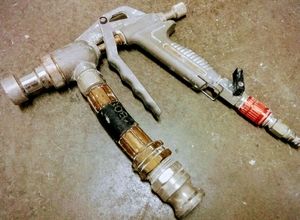
Orange peel texture is applied using small droplets of mud. A small nozzle size along with slightly higher than normal air pressure creates a fine mist of texture mud. Since the droplets of mud are small, they merge easily on the surface of the drywall and form a uniform film that resembles the peel of an orange.
In contrast, splatter knockdown texture is applied using a larger size nozzle and slightly lower air pressure which create bigger droplets of texture. The large droplets land as individual globules on the drywall surface. These droplets are later smoothed out to finish the knockdown texture.
Spraying Orange Peel Texture is Harder than Spraying Knockdown
The most difficult part of applying orange peel texture is maintaining a uniform thickness across the entire area being textured. Spraying an even orange peel texture is more difficult than spraying knockdown.
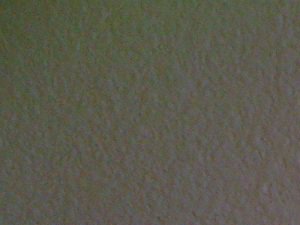 Spraying orange peel texture is similar to spraying paint on walls. However, when spraying paint with an airless sprayer, you usually back-roll the paint to smooth out any uneven areas. It is not possible to back-roll orange peel texture so it must be sprayed perfectly.
Spraying orange peel texture is similar to spraying paint on walls. However, when spraying paint with an airless sprayer, you usually back-roll the paint to smooth out any uneven areas. It is not possible to back-roll orange peel texture so it must be sprayed perfectly.
Since there is no additional knockdown step, applying orange peel drywall texture is slightly quicker than applying spatter knockdown. This is one reason why orange peel texture is more common in hotels and large commercial applications. After the orange peel texture has dried thoroughly, it can be primed and painted as normal.
Orange Peel Spray Equipment
Orange peel spray equipment can be divided into the following five categories:
- Large spray texture rigs
- Portable texture sprayers
- Hand-held spray texture hoppers
- Spray texture in a can
- Soft bristle brush and a paint stick
Spray Texture Rigs
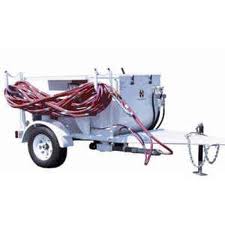 Large texture sprayers, or texture rigs, are used by professionals for large texture jobs. When spraying orange peel in hotels, hospitals, or other large commercial buildings, it is necessary to use a large texture sprayer with a capacity of 200 or more gallons.
Large texture sprayers, or texture rigs, are used by professionals for large texture jobs. When spraying orange peel in hotels, hospitals, or other large commercial buildings, it is necessary to use a large texture sprayer with a capacity of 200 or more gallons.
Spray rigs are usually mounted on a trailer with a gas-powered motor and air compressor. Powdered texture mud is often used instead of pre-mixed drywall mud. Powdered texture mud is mixed in a hopper similar to the way concrete mortar mixers work.
Portable texture sprayers
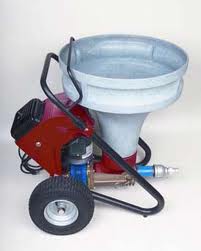 Portable texture sprayers with tanks that can hold between 5 and 10 gallons of texture mud are useful for smaller projects where you need to spray at least a few rooms. Graco® makes several different models of texture sprayers with different size hoppers and motors.
Portable texture sprayers with tanks that can hold between 5 and 10 gallons of texture mud are useful for smaller projects where you need to spray at least a few rooms. Graco® makes several different models of texture sprayers with different size hoppers and motors.
Some portable texture sprayers have built-in air compressors but many require a separate external air compressor. If you need to buy a separate air compressor to run your portable spray texture sprayer, make sure to get one that is sized big enough to keep up with the texture pump on the machine. Maintaining even air pressure is vital when spraying orange peel texture.
Portable texture sprayers are a good choice for professionals, even as a supplement to a large spray rig. Smaller texture sprayers are great for situations when you don't want to fire up the large trailer-mounted sprayer for a simple patch or small project.
Hand-held spray texture hoppers
Hand-held spray hoppers are lightweight and easy to operate. They can be used by do-it-yourself homeowners to repair small patches. Hand-held texture hoppers always require the use of an external air compressor. Small pancake air compressors are usually sufficient to keep up with the amount of mud sprayed.
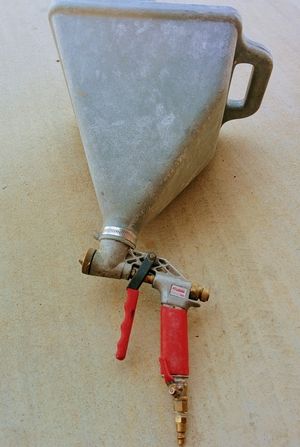
Since the texture mud in hand-held hoppers is gravity-fed to the nozzle, rather than pumped under pressure, it is difficult to produce an even spray pattern. Because these small hand-held texture hoppers rely on gravity to feed the nozzle. As the amount of mud in the hopper changes, it affects the size of globules extruded from the nozzle.
When using a hand-held hopper, some professionals have found success spraying orange peel using very thin mud. Thinner mud is less viscous so the pressure feeding the spray nozzle is less affected by changes in volume. When using thin texture mud, less air pressure is needed to maintain consistent size droplets.
Spray texture in a can
Spray texture in a can is used to texture small patches or repairs. Homax® sells drywall texture spray cans that work just like most aerosol cans. You can buy them specifically for spray knockdown or orange peel texture.
Though spray texture in a can is convenient for small patches or repairs, it is very difficult if not impossible to match the original texture using this method. You should always test the texture on a scrap piece of drywall before spraying the patch.
Soft bristle brush and paint stick
Orange peel texture can be applied using simply a soft bristle brush and a paint stick. When matching an existing orange peel texture after doing a drywall repair, most professionals simply pull out their small air compressor and hand-held texture hopper. However, if the patch is only a few inches in diameter, it may be possible to match an orange peel texture using a soft bristle brush and a paint stick.
If you have ever pulled your fingers across a wet brush, you are familiar with the way it splatters liquid in the opposite direction. A soft bristle brush can be used to splatter thin texture mud onto a drywall patch. To do this, the mud must be very thin.
The tips of the bristles are dipped into texture mud and a small stick is used to pull the bristles along the brush. The brush should be pointed toward the patch and the bristles pulled in the opposite direction of the patch. As the bristles spring back into place, they splatter droplets of mud onto the patch.
Is orange peel texture good for new construction?
There is nothing wrong with choosing to use orange peel texture for new construction. The choice of texture is usually based on design preferences. There are, however, a few principles to keep in mind when deciding whether or not to use orange peel texture for new construction.
Whether or not orange peel texture should be used in new construction depends mostly on design preference. However, it is good to remember that an orange peel texture is very difficult to match. It may be hard to find a tradesman in your area with enough experience and large enough equipment to apply orange peel texture.
Like with all types of sprayed drywall texture, the look of the final product depends on the consistency of the mud, the ambient temperature, humidity levels, the air pressure used, the equipment used, and of course the skill of the tradesman. It is almost impossible to recreate conditions exactly like they were when the original texture was applied.
Though orange peel texture may be appealing for its ease of initial application and ability to cover imperfections, matching this type of texture on drywall patches in the future will be very difficult. Areas that get a lot of traffic or are subject to updates are likely going to require drywall repairs and retexturing.
Conclusion
Orange peel texture is popular for large commercial applications because it covers imperfections relatively well and can be applied quickly using large spray rigs. It is very difficult to match an orange peel texture. Orange peel texture is applied with texture nozzles that use compressed air to atomize drywall and spray a fine mist of droplets across the surface being textured.


